
Browse an alphabetical list of photographs. These historical images portray people, places, and events before, during, and after World War II and the Holocaust.
<< Previous | Displaying results 391-400 of 2641 for "Photo" | Next >>
Cover to György Beifeld's album, featuring a road sign with the Hungarian Labor Service company number 109/13 posted in a muddy wasteland. The Jewish labor servicemen were forced to construct roads on these muddy fields to accommodate the advance of the Hungarian 2nd Army toward the Don River.
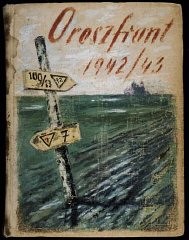
In a take-off of travel posters advertising peaceful vacation spots, Beifeld draws a picture of a Hungarian military tent pitched next to a tree on which a bird is cheerfully chirping. Next to the tent the artist writes "Peaceful Surroundings" but above, a Soviet bomber releases a bomb aimed at the tent. [Photograph #58022]
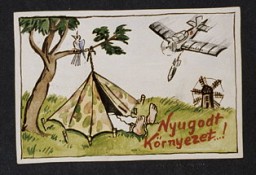
Belongings of a Jewish family murdered by an SS mobile killing squad at Babyn Yar. On September 29-30, 1941, the SS killed more than 33,000 Jews from Kyiv (Kiev). A German Propaganda Company photographer took this image within days of the massacre. Kyiv, German-occupied Soviet Union, after September 30, 1941.

Clothing belonging to Jewish victims murdered by the SS at the nearby Babyn Yar killing site. Prior to the mass shootings, the SS ordered Jews to undress and leave their belongings. They then marched or drove the victims to the killing site. A German photographer took this image within days of the mass shootings. Kyiv (Kiev), German-occupied Soviet Union, after September 30, 1941.
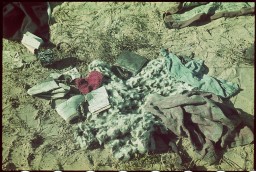
The SS ordered Jews to undress prior to the mass shootings at the nearby Babyn Yar killing site. In two days, September 29-30, 1941, they shot more than 33,000 Jews from Kyiv (Kiev). This photograph, taken by a member of a German Propaganda Company, shows just some of the belongings of these victims. Kyiv, German-occupied Soviet Union, After September 30, 1941.
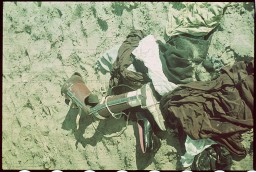
Belongings of Jews who were deported from Vienna. Austria, 1941–42.
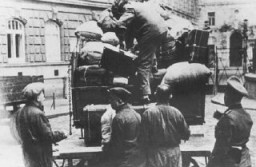
Ben Kamm in uniform after the war. Ben escaped from the Warsaw ghetto and joined partisan units to resist the Nazis. At the end of the war he discovered he was the sole survivor of his entire family.
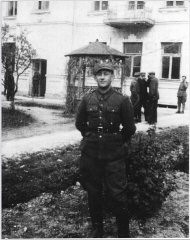
Benito Mussolini and Adolf Hitler stand together on an reviewing stand during a official visit to occupied Yugoslavia, 1941–43.
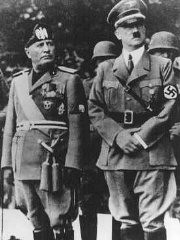
Benjamin Meed (right) and Harvey Meyerhoff stand next to the cornerstone for the United States Holocaust Memorial Museum. In October 1988, President Ronald Reagan spoke at a special ceremony held when the cornerstone of the Museum was laid, with construction beginning in July 1989 and ending in April 1993. Washington, DC, 1988.
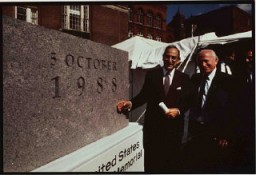
While living in hiding on the Aryan side of Warsaw, Benjamin Miedzyrzecki (Ben Meed) returns to the site of the Warsaw ghetto, where he poses among the ruins. Warsaw, Poland, 1944.

We would like to thank Crown Family Philanthropies, Abe and Ida Cooper Foundation, the Claims Conference, EVZ, and BMF for supporting the ongoing work to create content and resources for the Holocaust Encyclopedia. View the list of donor acknowledgement.